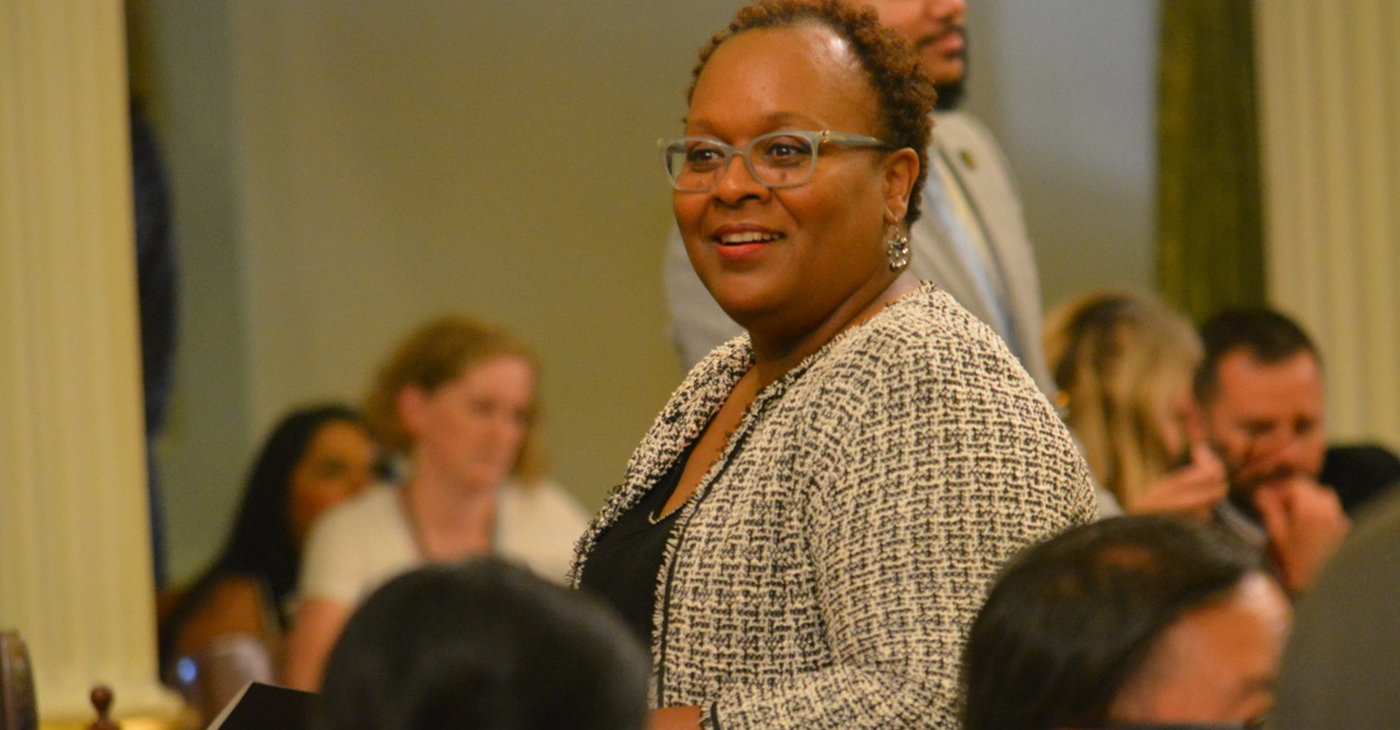Bay Area
2024 in Review: 7 Questions for Outgoing Black Caucus Chair Asm. Lori Wilson
A native Californian raised on the west side of Fresno, Assemblymember Lori D. Wilson (D-Suisun City) is married to her high school sweetheart, Chavares Wilson, a retired Air Force Reserve Technical Sergeant. They have been blessed with two sons, Tyler and Kiren, a daughter-in-law, Brittney, and a grandson, Weston. California Black Media (CBM) spoke with Wilson about her accomplishments, challenges and lessons she learned over the last year.

By Edward Henderson, California Black Media
Assemblymember Lori D. Wilson (D-Suisun City) was elected in a special election in April 2022 to represent California’s 11th Assembly District, which includes all of Solano County and portions of Contra Costa and Sacramento Counties.
In August of 2022, Wilson was elected Chair of the California Legislative Black Caucus (CLBC). Her tenure ended this month.
In the Assembly — and as CLBC Chair — Wilson says she has prioritized bringing state services directly to individuals, local businesses, veterans, non-profits, and local governments.
A native Californian raised on the west side of Fresno, Wilson is married to her high school sweetheart, Chavares Wilson, a retired Air Force Reserve Technical Sergeant. They have been blessed with two sons, Tyler and Kiren, a daughter-in-law, Brittney, and a grandson, Weston.
California Black Media (CBM) spoke with Wilson about her accomplishments, challenges and lessons she learned over the last year.
Responses have been edited for length and clarity.
Looking back at 2024, what stands out to you as your most important achievement as Chair of the CLBC and why?
The End of Slavery Act — getting that across the finish line and to voters as Prop 6. It was a central piece of our reparations legislative package. It failed last year at the very end. I was so disappointed.
How did your leadership contribute to improving the lives of Black Californians?
Well, I think, for sure, there are so many of us; we’re disproportionately impacted by the carceral system, and so if we can get this language changed, I think it will make an impact to ensuring that Black Californians in the system have dignity as well as truly get an opportunity to rehabilitate.
On the education bond, I was instrumental in getting the add-on language for resources like school kitchen facilities to have more access to produce and farmers markets.
On the climate bond, I was instrumental in getting the agriculture section in there with a substantial number of investments.
What frustrated you the most over the last year?
My greatest frustration is centered around misinformation and the weaponization of people. Stakeholders in the community who are lobbying directly on bills when they’re not getting their way, or something happens, they go to the community with soundbites and try to weaponize the community against something that might be beneficial.
What inspired you the most over the last year?
Always people.
What is one lesson you learned in 2024 that will inform your decision-making next year?
Behind my nameplate, there was a card there since 2015. Somebody wrote down a quote from Jerry Brown. It says, “the challenge is to build for the future, not steal from it.” That is such a profound statement.
In one word, what is the biggest challenge Black Californians face?
Familiarity. People are so familiar with our struggle that they minimize it. Other people struggle, but ours is so just so familiar that you have to remind people how terrible it is. You have to remind people what racism looks like.
What is the goal you want to achieve most in 2025?
Increasing the quality of life of people in California.
Activism
Oakland Post: Week of May 21 – 27, 2025
The printed Weekly Edition of the Oakland Post: Week of May 21 – 27, 2025

To enlarge your view of this issue, use the slider, magnifying glass icon or full page icon in the lower right corner of the browser window.
Bay Area
Chevron Richmond Installs Baker Hughes Flare.IQ, Real-time Flare Monitoring, Control and Reduction System
While the sight of flaring can cause concern in the community, flares are essential safety systems that burn pollutants to prevent them from being released directly into the atmosphere. They activate during startup and shut-down of facility units or during upsets or equipment malfunctions. The typical flare stack is about 200 feet high so that vapors are well above street levels.

The Richmond Standard
Chevron Richmond recently installed flare.IQ, a real-time, automated system that will improve the facility’s flaring performance.
The technology, developed by Panametrics, a Baker Hughes business, uses sensors to monitor, reduce and control flaring in real time. It collects and assesses data on refinery processes, such as temperature, pressure, gas flow and gas composition, and adjusts accordingly to ensure flares burn more efficiently and cleanly, leading to fewer emissions.
“The cleaner the flare, the brighter the flame can look,” said Duy Nguyen, a Chevron Richmond flaring specialist. “If you see a brighter flame than usual on a flare, that actually means flare.IQ is operating as intended.”
While the sight of flaring can cause concern in the community, flares are essential safety systems that burn pollutants to prevent them from being released directly into the atmosphere. They activate during startup and shut-down of facility units or during upsets or equipment malfunctions. The typical flare stack is about 200 feet high so that vapors are well above street levels.
“A key element in Baker Hughes’ emissions abatement portfolio, flare.IQ has a proven track record in optimizing flare operations and significantly reducing emissions,” said Colin Hehir, vice president of Panametrics, a Baker Hughes business. “By partnering with Chevron Richmond, one of the first operators in North America to adopt flare.IQ, we are looking forward to enhancing the plant’s flaring operations.”
The installation of flare.IQ is part of a broader and ongoing effort by Chevron Richmond to improve flare performance, particularly in response to increased events after the new, more efficient hydrogen plant was brought online in 2019.
Since then, the company has invested $25 million — and counting — into flare minimization. As part of the effort, a multidisciplinary refinery team was formed to find and implement ways to improve operational reliability and ultimately reduce flaring. Operators and other employees involved in management of flares and flare gas recovery systems undergo new training.
“It is important to me that the community knows we are working hard to lower emissions and improve our flaring performance,” Nguyen said.
Also evolving is the process by which community members are notified of flaring incidents. The Community Warning System (CWS), operated by Contra Costa County is an “all-hazard” public warning system.
Residents can opt-in to receive alerts via text, e-mail and landline. The CWS was recently expanded to enable residents to receive notifications for “Level 1” incidents, which are considered informational as they do not require any community action.
For more information related to these topics, check out the resources included on the Chevron Richmond, CAER and Contra Costa Health websites. Residents are also encouraged to follow @chevronrichmond and @RFDCAOnline on Facebook and X (formerly Twitter), where additional information may be posted during an incident.
Activism
Oakland Hosts Town Hall Addressing Lead Hazards in City Housing
According to the city, there are 22,000 households in need of services for lead issues, most in predominantly low-income or Black and Latino neighborhoods, but only 550 to 600 homes are addressed every year. The city is hoping to use part of the multimillion-dollar settlement to increase the number of households served each year.

By Magaly Muñoz
The City of Oakland’s Housing and Community Development Department hosted a town hall in the Fruitvale to discuss the efforts being undertaken to remove lead primarily found in housing in East and West Oakland.
In 2021, the city was awarded $14 million out of a $24 million legal settlement from a lawsuit against paint distributors for selling lead-based paint that has affected hundreds of families in Oakland and Alameda County. The funding is intended to be used for lead poisoning reduction and prevention services in paint only, not water or other sources as has been found recently in schools across the city.
The settlement can be used for developing or enhancing programs that abate lead-based paint, providing services to individuals, particularly exposed children, educating the public about hazards caused by lead paint, and covering attorney’s fees incurred in pursuing litigation.
According to the city, there are 22,000 households in need of services for lead issues, most in predominantly low-income or Black and Latino neighborhoods, but only 550 to 600 homes are addressed every year. The city is hoping to use part of the multimillion-dollar settlement to increase the number of households served each year.
Most of the homes affected were built prior to 1978, and 12,000 of these homes are considered to be at high risk for lead poisoning.
City councilmember Noel Gallo, who represents a few of the lead-affected Census tracts, said the majority of the poisoned kids and families are coming directly from neighborhoods like the Fruitvale.
“When you look at the [kids being admitted] at the children’s hospital, they’re coming from this community,” Gallo said at the town hall.
In order to eventually rid the highest impacted homes of lead poisoning, the city intends to create programs and activities such as lead-based paint inspections and assessments, full abatement designed to permanently eliminate lead-based paint, or partial abatement for repairs, painting, and specialized cleaning meant for temporary reduction of hazards.
In feedback for what the city could implement in their programming, residents in attendance of the event said they want more accessibility to resources, like blood testing, and information from officials about lead poisoning symptoms, hotlines for assistance, and updates on the reduction of lead in their communities.
Attendees also asked how they’d know where they are on the prioritization list and what would be done to address lead in the water found at several school sites in Oakland last year.
City staff said there will be a follow-up event to gather more community input for programming in August, with finalizations happening in the fall and a pilot launch in early 2026.
-

 #NNPA BlackPress3 weeks ago
#NNPA BlackPress3 weeks agoMLK Bust Quietly Removed from Oval Office Under Trump
-

 Activism3 weeks ago
Activism3 weeks agoOakland Post: Week of May 7 – 13, 2025
-

 Activism3 weeks ago
Activism3 weeks agoOakland Post: Week of April 30 – May 6, 2025
-

 #NNPA BlackPress3 weeks ago
#NNPA BlackPress3 weeks agoTrump Abruptly Fires First Carla Hayden: The First Black Woman to Serve as Librarian of Congress
-

 Activism1 week ago
Activism1 week agoNew Oakland Moving Forward
-

 Activism1 week ago
Activism1 week agoAfter Two Decades, Oakland Unified Will Finally Regain Local Control
-

 #NNPA BlackPress3 weeks ago
#NNPA BlackPress3 weeks agoBlack America Celebrates African Descent Heritage of Pope Leo XIV
-

 Alameda County1 week ago
Alameda County1 week agoOakland Begins Month-Long Closure on Largest Homeless Encampment






















































